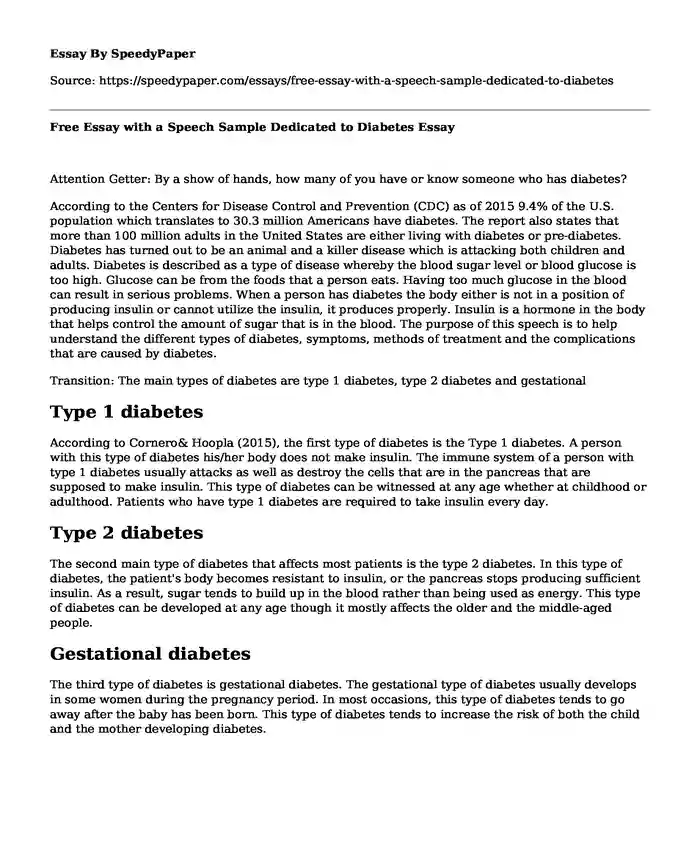Attention Getter: By a show of hands, how many of you have or know someone who has diabetes?
According to the Centers for Disease Control and Prevention (CDC) as of 2015 9.4% of the U.S. population which translates to 30.3 million Americans have diabetes. The report also states that more than 100 million adults in the United States are either living with diabetes or pre-diabetes. Diabetes has turned out to be an animal and a killer disease which is attacking both children and adults. Diabetes is described as a type of disease whereby the blood sugar level or blood glucose is too high. Glucose can be from the foods that a person eats. Having too much glucose in the blood can result in serious problems. When a person has diabetes the body either is not in a position of producing insulin or cannot utilize the insulin, it produces properly. Insulin is a hormone in the body that helps control the amount of sugar that is in the blood. The purpose of this speech is to help understand the different types of diabetes, symptoms, methods of treatment and the complications that are caused by diabetes.
Transition: The main types of diabetes are type 1 diabetes, type 2 diabetes and gestational
Type 1 diabetes
According to Cornero& Hoopla (2015), the first type of diabetes is the Type 1 diabetes. A person with this type of diabetes his/her body does not make insulin. The immune system of a person with type 1 diabetes usually attacks as well as destroy the cells that are in the pancreas that are supposed to make insulin. This type of diabetes can be witnessed at any age whether at childhood or adulthood. Patients who have type 1 diabetes are required to take insulin every day.
Type 2 diabetes
The second main type of diabetes that affects most patients is the type 2 diabetes. In this type of diabetes, the patient's body becomes resistant to insulin, or the pancreas stops producing sufficient insulin. As a result, sugar tends to build up in the blood rather than being used as energy. This type of diabetes can be developed at any age though it mostly affects the older and the middle-aged people.
Gestational diabetes
The third type of diabetes is gestational diabetes. The gestational type of diabetes usually develops in some women during the pregnancy period. In most occasions, this type of diabetes tends to go away after the baby has been born. This type of diabetes tends to increase the risk of both the child and the mother developing diabetes.
Transition: Symptoms of diabetes
Type 1 diabetes tend to develop more quickly, and therefore it can result in diabetic ketoacidosis or loss of weight. According to Gadsby&Gadsby (2009), type 2 diabetes can cause dark patches in the folds of the skin on the neck or armpits. Type 2 diabetes can cause numbness or pain in the feet since it takes a longer time to diagnose. Other general symptoms of diabetes include slow healing wounds, frequent urination, dry skin and excessive thirst and hunger.
Transition: Treatment of Diabetes
According to (Joslin2012), type 1 diabetes is normally treated with insulin. Meal planning also helps in ensuring that the right blood sugar level is maintained. The treatment of type 2 diabetes tends to depend on the severity of the level of diabetes. Type 2 diabetes can be managed through meal planning, physical activities or the use of insulin to be able to control the blood sugar level more effectively.Image of a person injecting insulin
Transition: Diabetic Complications
High -blood sugar levels result in diabetic-related complications. Such complications include foot problems, chronic kidney disease, heart attack, damage of the nerves, stroke and eye disease which can sometimes cause blindness.
In conclusion, diabetes is caused by high sugar levels in the blood. The main types of diabetes are type 1 diabetes, type 2 diabetes, and gestational diabetes. Some of the diabetic symptoms include dry skin, slow healing of wounds, excessive thirst and hunger as well as frequent urination. There major treatment for diabetes is the use of insulin.
References
Cornero, J., & Hoopla digital. (2015). Diabetes. United States: Dreamscape Media, LLC.
Gadsby, R., &Gadsby, P. (2009). Vital diabetes management. London: Class Health.
In Schwarz, P., & In Reddy, P. (2013). Prevention of diabetes.
Joslin, E. P. (2012). Treatment of diabetes mellitus. Place of publication not identified: Rarebooksclub Com.
Cite this page
Free Essay with a Speech Sample Dedicated to Diabetes. (2022, Mar 30). Retrieved from https://speedypaper.net/essays/free-essay-with-a-speech-sample-dedicated-to-diabetes
Request Removal
If you are the original author of this essay and no longer wish to have it published on the SpeedyPaper website, please click below to request its removal:
- Student Leader Role Essay Example
- Paradox in Metaphysics: The Ship of Theseus, Free Essay in Philosophy
- Event Analysis Essay, Free Example for Everyone
- Essay Sample: Global Warming and Its Causes
- Law Essay Example: The Case of Violation of EMTALA Provisions
- Essay Sample: Introduction to Nuclear National Security
- Free Essay Example. The Genetics of the Origin of Humans
Popular categories





